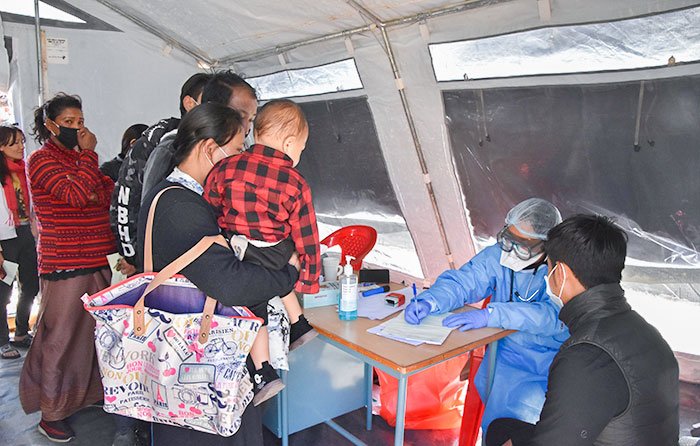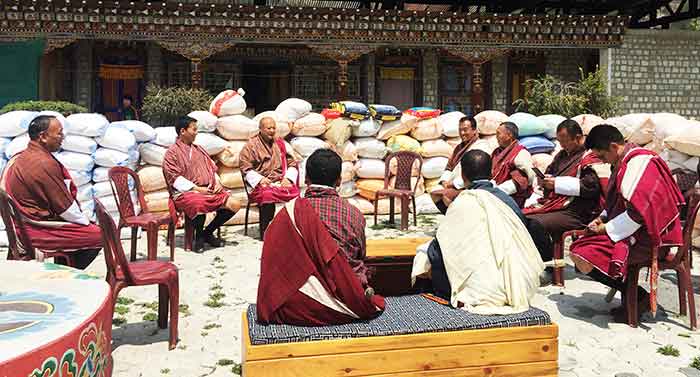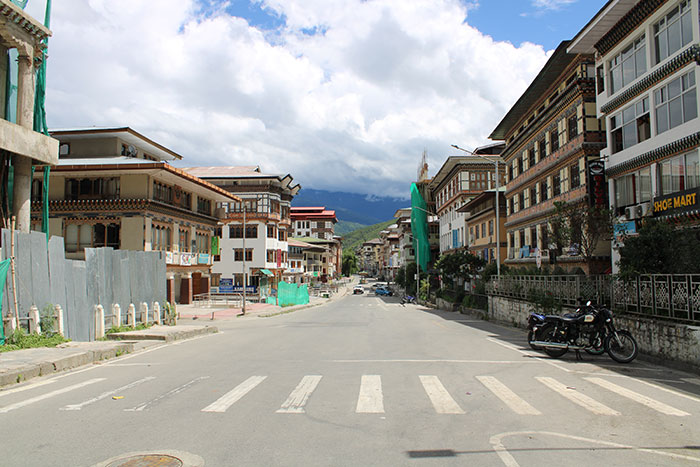September 9, 2020
The story continues
Bhutanese were startled out of sleep in the early hours of March 6, when the Prime minister’s Office announced on social media the first novel coronavirus case in the country.
Prime Minister Dr Lotay Tshering announced the details over live television from the courtyard of the Parliament building, which was to host the conclusion of the third session of the third Parliament. Members of Parliament, senior government officials and media attended the briefing as the Lyonchhen and the health minister took turns to disclose every detail of what transpired the previous night.
A 76-year-old American tourist tested positive. The ministry traced all those who have come in contact with him and they all tested negative to the virus. 34 health personnel including two specialists and 16 clinical nurses looked after the patient. The country is marked an orange zone.
The government immediately banned tourists, closed schools and institutes in Thimphu, Paro and Punakha, where the tourist visited, for two weeks. On March 18, all schools closed indefinitely. The government reopened classes X and XII on July 1. Lessons were broadcast on television and self-learning materials distributed to rural schools and those who don’t have access to online learning.
Medical shops ran out of hand sanitisers. The health ministry improvised and distributed free sanitiser, made of spirit and glycerin for the first few days.
Hundreds queued to collect free sanitisers. De-Suups drove around the town distributing sanitisers from large barrels. It was also distributed in Paro, Punakha, and Wangdue.
More than 56 flu clinics were set up across the country to step up surveillance.
Meanwhile, the country’s index case left for home on March 13. A few days later, his 59-year-old partner tested positive. The government announced a mandatory 14-day quarantine for all entering the country at the points of entry and closed the gates on March 23. The quarantine period was later extended to 21 days.
The first Bhutanese to test positive for the virus was a female student who returned from Europe. She tested positive while in the quarantine centre on March 25. So far, 233 Bhutanese tested positive to Covid-19.
The preparations the country made with guidance from His Majesty The King, received much international acclaim for handling the threat and cases of Covid-19.
There are 54 flu clinics in the country today (File photo)
Before Covid-19 hit Bhutan
On January 15, a day after the WHO announced the first confirmed case in Thailand, the health ministry issued the first public cautionary notice regarding the outbreak of pneumonia caused by the new coronavirus in Wuhan, Hubei Province in China. As a precaution, the ministry stationed thermal scanners and began surveillance of respiratory symptoms at the Paro International Airport. There was no travel or import ban from the affected places yet.
In coordination with the immigration department, collection of local contact addresses and health screening of passengers arriving from China at the Paro airport began January 22. Travellers were educated on the infection with the in-flight announcement in both the national airlines from January 17.
On January 21, health officials held an internal coordination meeting to discuss preparedness and way forward. All health centres including the national referral hospital in Thimphu were notified to strengthen and step-up surveillance and report to the Royal Centre for Disease Control (RCDC). An interim guideline and case investigation forms were also circulated to all health facilities.
By the end of January, the WHO declared coronavirus as a global emergency as it infected 7,816 and claimed 170 lives. WHO reported that as of January 7,818 total confirmed cases worldwide, with the majority of these in China, and 82 cases reported in 18 countries outside China. WHO gave a risk assessment of very high for China, and high at the global level.
By then the health ministry instituted measures at various entry points, identified health facilities and response teams in case of an outbreak in the country. A system was in place and the ministry equipped itself to deal with an outbreak. It issued cautionary notification and travel advisories to the public and health centres.
JDWNRH was identified as patient isolation rooms and critical units. The old Mother and Child Health unit with the hospital was converted into the isolation unit. Teams consisting of management staff, and health personnel were formed to ensure quick response in case of an outbreak. Paro, JDWNRH and Phuentsholing hospitals were prioritised given the risks to infection.
With numerous claims of a cure going viral on social media, the health minister had to denounce them publicly.
“We are worried because in the social media people are claiming that herbal bills (ribs) and talisman (sungkey) could prevent one from the infection and advertising them for sale. That could be well and good but to us, that is the wrong information that is going to the public,” Lyonpo said.
As a precautionary measure, numerous international and regional meetings to be hosted in the country were cancelled.
Between January 1 and February 7, of the 2,890 tourists who visited Bhutan 629 were Chinese. Of the 358 cancellations till February 7, 197 gave coronavirus as the reason for cancellation and of that 52 were Chinese. The royalty that the government collected were refunded. Airlines were refunding airfare.
By the first week of February, posters on prevention of the virus went in the capital and mainly the southern border areas. Health ministry officials toured the entry points to inspect screening measures.
The country was preparing for the worst situation of the Covid-19 outbreak as WHO placed the region at a high risk of getting infected while China was at very high risk.
The monastic community spearheaded by the Central Monastic Body began prayers and rituals to abate the risks of the disease. His Holiness the Je Khenpo administered the Sangay Menlha initiation and blessing virtually and urged all Bhutanese to obey health advice.
The country had its first suspected case, a Chinese tourist in Bumthang. She was suspected of the infection and was immediately airlifted to Thimphu where it turned out negative.
A German couple suspected of contracting the virus tested negative in Phuentsholing on March 5, a day before the country report the first case. The country’s major industries, mainly those in the tourism sector, suffered adverse impacts.
April was all about kidu and helping those affected by the pandemic.
Druk Gyalpo’s Relief Kidu came to the rescue of those who lost their livelihoods and jobs. Kidu recipients received their first monthly allowance on April 30. The government announced relief measures amounting to Nu 3.37 billion. It also altered the 2020-21 fiscal budget and saved about Nu 3B to meet the cost of Covid-19.
The government also announced a tourism stimulus package to benefit 2,436 people. The Royal Monetary Authority announced more than Nu 500 million in short term loans to import raw materials.
Gups of Paro handover the goods and money contributed by villagers to an official from the Gyalpoi Zimpon’s Office in the presence of Paro Dzongdag.
Coming together
Farmers sent free vegetables, rice, and dairy products to the quarantine centres and house owners waived rents. Banks deferred loans installments for three months and interest was waived as a kidu from His Majesty. In a show of gratitude and solidarity, companies and individuals contributed to the Covid-19 relief funds set up with His Majesty’s secretariat and the finance ministry. Some travel companies and hotels continued to pay their employees for the initial few months.
International donor agencies deposited their bit and committed more.
Tour guides out of work took to growing vegetables, some joined the thromde’s workforce and a few others returned to their villages. Some drayang dancers became parking fee collectors.
While the first three Bhutanese Covid-19 patients recovered on April 10, more Bhutanese continued to return from abroad which needed more quarantine centres.
To prevent further risks, all shops and business centres were closed by 7pm from April 14. In May, more than 5,000 families living in Jaigaon moved into free kidu shelters along the Toorsa bank in Phuentsholing.
Digitisation took a major leap in various fields such as agriculture and education. Students were provided cheap data packages and farmers were encouraged to auction their farm produce through the online platforms. Online banking increased and shopping sites cashed in – RMA declared that more than Nu 1 billion were transacted online until August.
May ended with a first Covid-19 positive case in Phuentsholing, an imported in a woman who returned from India. There were 31 positive cases – all imported.
By the end of June, the government had declared that local transmission was imminent and that it was only a matter of time. All efforts were made towards enhancing testing, tracing and treatment.
On the command of His Majesty The King, the second phase of relief measures, including loan interest waivers, benefiting more than 112,024 across the country was announced on June 27.
The health ministry was giving the final touches to the lockdown protocol and Jaigaon was under lockdown at the beginning of August. The country had recorded 110 Covid-19 positive cases. The capital’s lockdown protocol was put to test when a rumour of three Covid-19 positive individuals went viral.

Lockdown
On August 11, a woman in Gelephu tested positive for Covid-19 following which the government declared the 21-day nationwide lockdown. Two days later, 12 positive cases were reported from the mini-dry port in Phuentsholing.
Bhutan learnt many lessons from the first-ever lockdown. Communication lines were critical in times of such emergencies. The authorities gave private mobile numbers. Some officials were not even at their workplace.
There was an increasing number of complaints about the numbers either not responding or remaining engaged all the time. The other issue was that the numbers kept revising and finally a large number of toll-free numbers were opened.
The health ministry was extremely cautious in releasing details of the patients citing privacy and ethical concerns. But at the end of the lockdown came out with a host of details on the cases.
The new zoning system exposed the terrible state of the country’s address system. Surveillance teams had to seek help from taxi drivers to get to the homes of those who had come in contact with the index cases.
The country had the best of SoPs on paper but experienced teething problems in implementing on numerous accounts. “With no proper system or data in place coordination became a nightmare,” an official said.
The agencies today have improved on all these fronts to help authorities take strategic and timely decisions.
All these lessons would be critical for future lockdowns, as the Health Minister Dechen Wangmo said, “There is no end to coronavirus, we should live with it.”
Source: Kuensel